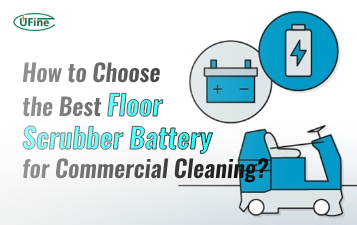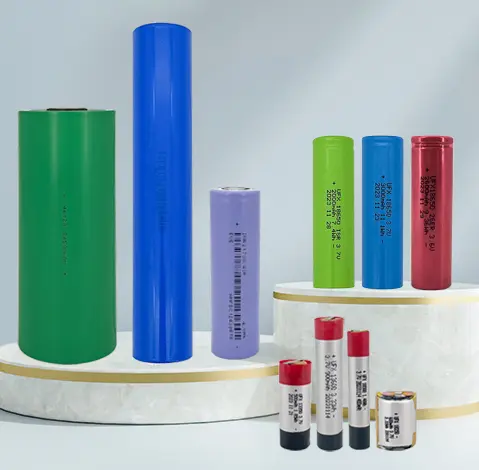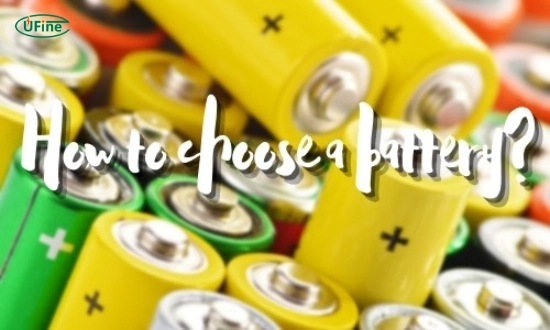Choosing the right flashlight battery size can be overwhelming, as there are many different flashlight battery types and sizes available. Whether you’re looking for the best rechargeable flashlight battery or comparing 18650 vs 26650 batteries, understanding which type is best suited for your flashlight can significantly improve its performance. In this detailed guide, we’ll explore various flashlight battery types, sizes, and provide expert tips for choosing the best flashlight battery for your specific needs.
Part 1. Flashlight battery types
Flashlight batteries come in three primary categories: Lithium Batteries, NiMH Batteries, and Other types. Each type offers distinct advantages and is suitable for different applications.
- Lithium Batteries: Known for their high energy density and long shelf life, lithium batteries are a popular choice for flashlights. They come in various sizes, including 18650, 26650, 21700, and more.
- NiMH Batteries: Nickel-metal hydride batteries are rechargeable and offer a cost-effective solution for flashlight users. Standard sizes include AA, AAA, C, D, and 9V block batteries.
- Other types of flashlight batteries: This category includes alternative battery options such as 6V and 12V block batteries and the smaller 4LR44, also known as AG13.
Part 2. Flashlight battery Size
Lithium Batteries:
18650 battery
- Specifications: The 18650 battery measures 18mm in diameter and 65mm in length, with a voltage of 3.7V and a capacity typically ranging from 2500mAh to 3500mAh.
- Features: 18650 batteries, known for their high energy density and long lifespan, are ideal for high-performance flashlights.
- Suitability: Ideal for tactical flashlights, high-powered LED flashlights, and other devices requiring long runtime and high output.
26650 battery
- Specifications: The 26650 battery is more extensive, with a diameter of 26mm and a length of 65mm, offering a voltage of 3.7V and a capacity typically ranging from 4000mAh to 5000mAh.
- Features: These batteries provide higher capacity and longer runtime, making them suitable for heavy-duty flashlights.
- Suitability: Commonly used in searchlights, high-lumen flashlights, and powerful handheld spotlights for outdoor activities.
21700 battery
- Specifications: The 21700 battery measures 21mm in diameter and 70mm in length, with a voltage of 3.7V and a capacity typically ranging from 3500mAh to 4500mAh.
- Features: 21700 batteries, which balance capacity and performance, are increasingly popular in modern flashlight designs.
- Suitability: Suitable for everyday carry (EDC) lights, bike lights, and tactical flashlights requiring a smaller form factor.
16340 (CR123A) battery
- Specifications: The 16340 battery, also known as CR123A, has a diameter of 16mm and a length of 34mm, with a voltage typically ranging from 3.0V to 3.7V and a capacity varying from 600mAh to 1000mAh.
- Features: CR123A batteries offer high voltage and excellent shelf life, making them ideal for devices requiring long-term storage or infrequent use.
- Suitability: Commonly used in compact flashlights, weapon-mounted lights, and surveillance cameras due to their small size and high energy output.
14500 battery
- Specifications: The 14500 battery has a diameter of 14mm and a length of 50mm, providing a voltage of 3.7V and a capacity typically ranging from 600mAh to 1000mAh.
- Features: Similar in size to AA batteries, 14500 lithium batteries offer higher voltage and energy density, making them suitable for compact flashlights with demanding power requirements.
- Suitability: Ideal for mini flashlights, penlights, and keychain lights where space is limited but performance is essential.
18350 battery
- Specifications: The 18350 battery has a diameter of 18mm and a length of 35mm, with a voltage of 3.7V and a capacity typically ranging from 800mAh to 1200mAh.
- Features: Despite their shorter length, 18350 batteries offer decent capacity and power output, making them suitable for compact flashlight designs without sacrificing performance.
- Suitability: Commonly used in small and medium-sized flashlights, especially those requiring a shorter form factor for portability or concealment.
10180 battery
- Specifications: The 10180 battery is ultra-compact, measuring 10mm in diameter and 18mm in length, with a voltage of 3.7V and a capacity typically ranging from 70mAh to 120mAh.
- Features: Despite their small size, 10180 batteries offer compactness and convenience. They are suitable for micro flashlights and keychain lights where space is limited.
- Suitability: Suitable for pocket-sized flashlights, emergency lights, and keychain flashlights where space is limited but occasional use is expected.
CR2 battery
- Specifications: CR2 batteries have a diameter of 15.6mm and a length of 27mm, with a voltage typically ranging from 3.0V to 3.2V and a capacity varying from 600mAh to 900mAh.
- Features: CR2 batteries offer a combination of small size and decent capacity, making them suitable for specific flashlight designs.
- Suitability: Commonly used in laser pointers, digital cameras, and specific types of flashlights requiring a compact yet powerful energy source.
CR2450 battery
- Specifications: CR2450 batteries are coin cell batteries with a diameter of 24.5mm and a thickness of 5mm, providing a voltage of 3.0V and a capacity typically ranging from 600mAh to 700mAh.
- Features: Despite their small size, CR2450 batteries offer sufficient capacity for specific flashlight applications.
- Suitability: Occasionally used in specialty flashlights, keychain lights, and electronic devices where space is limited, and power consumption is relatively low.
NiMH Batteries:
AA (HR6) battery
- Specifications: AA batteries have a diameter of 14.5mm and a length of 50.5mm, providing a voltage of 1.2V and a capacity typically ranging from 2000mAh to 3000mAh.
- Features: NiMH AA batteries are rechargeable and offer good capacity and performance, making them a cost-effective and eco-friendly choice for flashlight users.
- Suitability: Suitable for a wide range of flashlight models, including everyday carry lights, camping lanterns, and household flashlights requiring AA batteries.
AAA (HR03) battery
- Specifications: AAA batteries have a diameter of 10.5mm and a length of 44.5mm, providing a voltage of 1.2V and a capacity typically ranging from 600mAh to 1000mAh.
- Features: AAA batteries are minor compared to AA batteries but offer similar performance and compatibility with rechargeable NiMH technology, making them suitable for compact flashlight designs.
- Suitability: Commonly used in mini flashlights, headlamps, and small electronic devices where limited space and lightweight power sources are required.
C (HR14) battery
- Specifications: C batteries have a diameter of 26.2mm and a length of 50mm, providing a voltage of 1.2V and a capacity typically ranging from 2500mAh to 4500mAh.
- Features: NiMH C batteries offer higher capacity and longer runtime than AA and AAA batteries, making them suitable for larger flashlights and devices with higher power requirements.
- Suitability: Ideal for heavy-duty flashlights, camping lanterns, and emergency lights where long-term use and reliability are essential.
D (HR20) battery
- Specifications: D batteries have a diameter of 34.2mm and a length of 61.5mm, providing a voltage of 1.2V and a capacity typically ranging from 5000mAh to 10000mAh.
- Features: D batteries are the largest among standard NiMH batteries. They offer the highest capacity and longest runtime, making them suitable for high-power flashlights and devices requiring sustained energy output.
- Suitability: Commonly used in industrial flashlights, emergency lighting systems, and outdoor lanterns where durability and performance are paramount.
9V block battery
- Specifications: 9V batteries have a rectangular shape with dimensions of approximately 26.5mm x 17.5mm x 48.5mm, providing a voltage of 9V and a capacity typically ranging from 400mAh to 600mAh.
- Features: Devices requiring multiple cells or compact power sources commonly use 9V block batteries, which provide high voltage.
- Suitability: Suitable for specific flashlight models, smoke detectors, wireless microphones, and other devices requiring a reliable and long-lasting power supply.
Other types of flashlight batteries:
6V block battery
- Specifications: 6V block batteries typically have dimensions of approximately 34mm x 17mm x 67mm, providing a voltage of 6V and a capacity normally ranging from 4000mAh to 8000mAh.
- Features: 6V block batteries offer higher voltage than standard AA or AAA batteries, making them suitable for specific flashlight models and devices requiring higher power output.
- Suitability: Commonly used in older flashlight designs, portable spotlights, and emergency lighting systems where compatibility with 6V power sources is essential.
12V block battery
- Specifications: 12V block batteries have dimensions of approximately 34mm x 17mm x 67mm, providing a voltage of 12V and a capacity typically ranging from 3000mAh to 6000mAh.
- Features: 12V block batteries provide even higher voltage than 6V batteries, making them suitable for specific flashlight models and devices requiring 12 volts of power.
- Suitability: Used in specialized flashlights, vehicle-mounted lights, and other applications where higher voltage is necessary for optimal performance.
4LR44 (AG13) battery
- Specifications: 4LR44 batteries are button cell batteries with a diameter of 11.6mm and a thickness of 5.4mm, providing a voltage of 1.5V and a capacity typically ranging from 100mAh to 200mAh.
- Features: Despite their small size, 4LR44 batteries offer sufficient voltage and capacity for specific flashlight applications.
- Suitability: Occasionally used in compact flashlights, keychain lights, and electronic devices requiring a low-profile power source.
Part 3. Choosing Tips for Flashlight Batteries
- Understand Your Flashlight’s Requirements: Before choosing a battery, it’s essential to understand your flashlight’s specifications, including its voltage, size, and power consumption.
- Consider Battery Chemistry: Flashlight batteries use various chemistries, such as lithium-ion, nickel-metal hydride (NiMH), and alkaline.
- Evaluate Voltage and Capacity: Pay attention to the battery’s voltage and capacity, as these factors directly impact the flashlight’s runtime and performance. Higher voltage batteries generally provide more power, while higher capacity batteries offer longer runtime between charges or replacements.
- Check Size and Form Factor: Using a battery that is too large or too small may result in poor fitment or damage to the flashlight.
- Consider Rechargeable Options: Rechargeable batteries can be a cost-effective and eco-friendly choice for frequent flashlight users. Consider investing in rechargeable lithium-ion or NiMH batteries and a compatible charger for long-term savings and convenience.
- Check Compatibility: Some flashlights only work with specific battery types or brands, as their design dictates. Check the manufacturer’s recommendations to ensure compatibility and avoid damaging your flashlight.
- Evaluate Environmental Conditions: Consider the environmental conditions in which you’ll use your flashlight. For extreme temperatures or outdoor activities, choose batteries with high-performance ratings and durability to withstand harsh conditions.
- Consider Long-Term Costs: Rechargeable batteries may have a higher upfront cost, but they can save money in the long run compared to disposable batteries.
Part 4. FAQs
-
What is the most common size for flashlight batteries?
The most common flashlight battery sizes are AA, AAA, CR123A, and 18650. The ideal size depends on your flashlight model and its power requirements. -
What is the difference between 18650 and 26650 flashlight batteries?
The 18650 battery is smaller than the 26650, with the latter offering a higher capacity (4000mAh to 5000mAh) and longer runtime, making it ideal for heavy-duty flashlights. -
How do you know battery size?
You can identify battery size by checking the label on the battery or referring to your flashlight’s user manual for compatibility information. -
What is the standard flashlight battery size?
The standard flashlight battery sizes include AA, AAA, and CR123A. However, some flashlights may use other sizes depending on their design and power requirements. -
Which batteries for flash?
For flash photography, photographers often use rechargeable lithium-ion or high-capacity AA batteries to provide quick and consistent power for their camera flash units.
Related Tags:
More Articles

How to Choose the Best Floor Scrubber Battery for Commercial Cleaning?
Selecting the ideal floor scrubber battery ensures a long runtime, rapid charging, and minimal maintenance for efficient commercial cleaning operations.
Battery for Blower vs Battery for Leaf Vacuum: Which One Should You Choose?
Battery for blower vs leaf vacuum—learn the key differences in power, fit, and runtime to choose the right battery for your outdoor tool needs.
How to Choose the Right Battery for Blower?
Choosing the right blower battery? Consider voltage, capacity, chemistry & usage. This guide helps match the best battery for peak performance.
How to Choose the Best Insulated Battery Box for Lithium Batteries?
Choosing the Best Insulated Battery Box for Lithium Batteries? Discover key factors such as size, material, and safety for optimal protection and performance.
7 Critical Elements on a Lithium Battery Shipping Label
What must be on a lithium battery shipping label? Learn 7 key elements to ensure safety, legal compliance, and correct handling across all transport modes.





